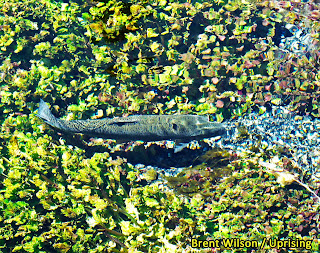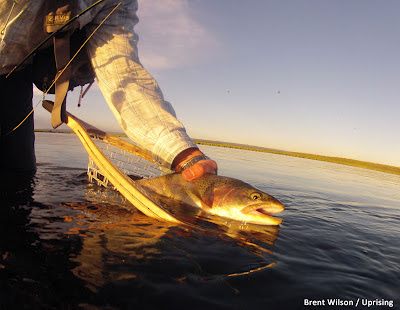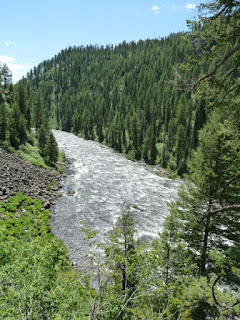If you've ever heard Rene Harrop or Mike Lawson describe the Henry's Fork river in eastern Idaho, you immediately sense the great reverence and respect these men have for the place. It is a river like no other I have ever observed. Having lived in Idaho for almost four years now, I am fortunate to have become a student of the Henry's Fork.
 |
| Upper Mesa Falls on the Henry's Fork |
The Railroad Ranch section within Harriman State Park completely humbles me every time I fish it; not just because it is one of the most challenging dry fly streams in the country (it kicks my ass on a regular basis), but because its serenity, abundance of life and sheer beauty are almost indescribable. An afternoon at the ranch is like having a front row seat in nature's amphitheater; where trout, insects, swallows, foxes and the occasional moose steal the show.
 |
| A Henry's Fork Rainbow |
While there are other sections of the river where you can consistently land back-to-back large trout, fishing the ranch is not a numbers game; it requires a different strategy altogether. You may spend 20 minutes sitting on the bank observing rise forms, then another five to ten minutes slowly working your way through gin clear water to get within casting range. Long leaders and light tippet are a must.
There are a lot of things that may go wrong, but when things go right, it's pretty amazing. I am beginning to understand why people come here from all over the world to fly fish. The rainbow trout in the Henry's Fork are some of the wiliest, feistiest fish around.
A lot of people obsess about matching the hatch here, but I think a good drag-free presentation is much more important than a perfect match. In fact, even when the mayfly and caddis hatches are in full swing, ant or beetle patterns have worked for me when other patterns didn't.
 |
| This Railroad Ranch Rainbow Rose to a Rusty Spinner |
 |
| A Long-Billed Curlew |

The ranch is open to fishing from June 15th to November 30th each year. During this time frame, hatches include caddis, PMDs, green drakes, brown drakes, flavs, yellow sallies, tricos, baetis and mahogany duns.
It's hard to explain the effect this place has on your head and your psyche. It's got its own unique rhythm and it's a great place to hone your skills. This is as challenging as trout fishing gets.
I haven't yet landed a true hog at Railroad Ranch, but there are plenty of them in there...and I'll be back.
I haven't yet landed a true hog at Railroad Ranch, but there are plenty of them in there...and I'll be back.











